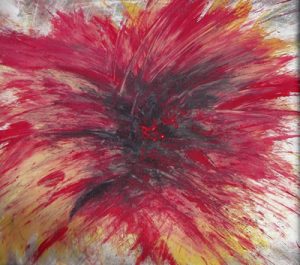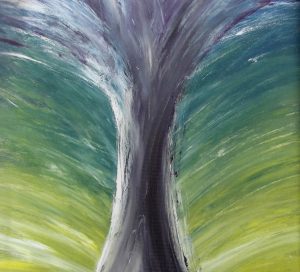Written by Naomi Ardea
Reviewed by Johnny Szeto and Nancy Eichhorn
Sexual abuse has long-lasting physical and emotional effects even years after the initial incident. Naomi Ardea, in her debut book, The Art of Healing from Sexual Trauma: Tending Body and Soul Through Creativity, Nature, and Intuition, invites readers to experience a profoundly intimate personal tale of abuse and survival as she journeyed through her own recovery. Ardea offers a rare in-depth view into the inner world of a sexual abuse victim as she struggled to regain peace, a sense of wholeness—her profound pain and confusion are real, the chaos and overwhelm present, the sanctuary and escape, the clarity and release poignant. Her soulful and soul-filled paintings swirling on the page (with retrospective reflection as to what was occurring when she created each painting and its impact on her body, psyche, soul), her tone setting photographs (that helped her to realize the way that changing perspectives with a camera lens, the angle for taking a shot, helped her to change her inner reactions to the world), and her authentic, compassionate words, often poetic in nature, offer outlets for the ripples of pain forever present in survivors and bring hope and healing to those still learning to cope in trying times.
Ardea writes with bodily expression, with movement in color, in text, in breath: “My pelvis feels inflamed, wobbly, twisted. It’s heavy like an overloaded water balloon. When I breathe and pay attention to my pelvis, I feel sadness well up, as though there’s an artesian well bursting up from my lower abdomen to fill my heart with sad, sad, waters. My hands feel prickly as all these waters overflow from my heart. They gust out in shaky waves down my arms and hands” (pg. 82).
The Art of Healing from Sexual Trauma is part memoir and part toolbox for victims of sexual violence.
Ardea introduces the book as a guided journal, a safe space where anyone can flip through her personal experiences and the art that arises when patching her wounds; she provides open writing and drawing spaces for those who want to explore their own feelings on these blank pages. And she offers a time out at the beginning of each chapter if the day isn’t right to work more intensely; Her mantra is the same: ”Feel like you need to avoid possible triggers today?” She then offers page numbers to skip forward to her creative self-care suggestions. To help readers ease out of a traumatized state she offers ideas such as self-talk, lying on the ground, journaling, dancing, crying/screaming/venting out any sounds, resting and aromatherapy and to redefine boundaries she offers colored light meditation, painting or drawing, cultivating inner awareness, rebuilding boundaries through the body and yogic breathing techniques.
Each chapter ends with creative self-care suggestions (A survivor’s tool box) for managing various circumstances that stunt the healing process including dissociation, anger, and self-blame. Each of the areas that make up the complex emotional web post-trauma are given various practical suggestions for healing: for those who self-blame, alternate nostril breathing can calm anxiety; for those who are consistently triggered, a salt bath might take away the emotional edge in those situations. There are empty pages after each chapter to make room for letting out the shame, rage, and pain that is typically pent up after experiencing sexual violence; there is no blame—only patience and hope.
Her Anatomy of Sexual Violation and Healing Care chart on page 115 offers readers a clear connection between a bodily symptom and possible self-care actions, followed by a blank chart to write in their own. A discussion on intuition comes next with Ardea noting changes, internal shifts in thoughts, emotions, and sensations, and what intuitive signals may look like (feel like). Many abuse victims disconnect from their body, lose the intuitive sense of what feels right and true, of what feels off kilter, plain old wrong and bad. She grounds intuition with easy to sense concepts such as, feeling sick or prickly or heavy usually means something isn’t right for her or that goosebumps or a rain-like feeling of energy flowing through her usually feelings like something is right to pursue (pg. 117).
Ardea confronts her feelings with a raw tenderness, her discussions with her own therapist about feeling twisted and sexually manipulated. Her words resonate as truth for many sexual abuse survivors—“I have doubts about speaking up and writing opening because it’s exhausting to sort through the opinions of those who blame. Or even to meet the silence of those just thinking rather than expressing those attitudes” (pg. 49).
For those who are reading this book to heal, it is a great beginning to the road to recovery. The practical self-care techniques are useful, but this book is merely a stepping stone through the path of healing. It provides perspective and is a model for those who feel alone. Victims are encouraged to release pent-up feelings through art and to embrace the visceral feelings that come up during this emotional process.
Acknowledging that help is needed might be the most challenging part of any situation. The Art of Healing from Sexual Trauma reaches out to those who feel lost. It is a thoughtful guide that victims, families, friends, and even allied health professionals can benefit from. And it includes a section on getting help from others, what to look for in a helping professional. For her, three characteristics came forth: “They have extensive knowledge of trauma, they communicate clearly about therapies and techniques, and they are adept at integrating the client’s internal, in-the-moment experiences into the consultation or therapy room (pg. 179). She recommends ways to choose help wisely and offers a list of therapies that she’s found helpful such as EMDR, Somatic Experiencing, Movement therapies (i.e., yoga, tai chi, Continuum Movement), and touch therapies and energy healing (i.e., EFT, polarity therapy, craniosacral therapy, and reiki).
For those hesitant to make the first step to heal their sexual abuse experience(s), Ardea’s book will be that initial push toward self-love and healing that many survivors.
To access the PDF of this review, CLICK HERE
Johnny Szeto has a Bachelor of Arts in Urban Design and Architecture Studies from New York University. He continues to do public health research at the CUNY School of Public Health on the psychosocial and physical effects of environmental design in low-income neighborhoods. In addition to working for IJP, he writes reviews for Somatic Psychotherapy Today.
To purchase Ardea’s book simply CLICK the Amazon link below










